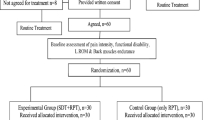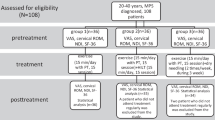Abstract
The aim of this trial is to investigate and compare the effects of phonophoresis (PP) and ultrasound (US) therapy on pain, disability, trunk muscle strength, walking performance, spinal mobility, quality of life (QOL), and depression in the patients with chronic low back pain (CLBP). A total of 60 patients with definite CLBP were included in this study. The patients were randomized into three groups. Group 1 (n = 20) was accepted as the control group and was given only exercises. Group 2 (n = 20) received US treatment and exercises. Group 3 (n = 20) received PP and exercises. All of the programs were performed 3 days a week, for 6 weeks. The pain (visual analog scale, VAS), disability (Oswestry Disability Questionnaire, ODQ and pain disability index, PDI), walking performance (6 min walking test, 6MWT), depression (Beck Depression Inventory scores, BDI), and QOL (Short Form 36, SF-36) of all participants were evaluated. The trunk muscle strength was measured with a handheld dynamometer. All of the groups showed statistically significant improvements in pain, disability, muscle strength, endurance, 6MWT, mobility, QOL, and depression. The intergroup comparison showed significant differences in VAS pain, 6MWT, and EMS, among three groups. These differences were statistically significant in groups 2 and 3 compared with the group 1. The intergroup comparison showed significant difference in pain, physical function, and energy subgroups of SF-36. The differences were statistically in group 3 compared with group 1 and 2. We observed that US and PP treatments were effective in the treatment of patients with CLBP but PP was not found to be superior over ultrasound therapy.
Similar content being viewed by others
References
Paolucci T, Morone G, Iosa M et al (2012) Psychological features and outcomes of the Back School treatment in patients with chronic non-specific low back pain. A randomized controlled study. Eur J Phys Rehabil Med 48(2):245–253
Frank AO, Souza LD (2001) Conservative management of low back pain. Int J Clin Pract 55:21–31
Nicolaisen T, Jorgensen K (1985) Trunk strength, back muscle endurance, and low-back trouble. Scand J Rehab Med 17:121–127
Yang EJ, Park W-B, Shin H-I et al (2010) The effect of back school integrated with core strengthening in patients with chronic low-back pain. Am J Phys Med Rehabil 89:744–754
Liddle SD, Baxter GD, Gracey JH (2004) Exercise and chronic low back pain: what works? Pain 107:176–190
Rainville J, Hartigan C, Martinez E et al (2004) Exercise as a treatment for chronic low back pain. Spine J 4:106–115
Ay S, Doğan SK, Evcik D et al (2011) Comparison the efficacy of phonophoresis and ultrasound therapy in myofascial pain syndrome. Rheumatol Int 31:1203–1208. Epub 2010 Mar 31
Rand SE, Goerlich C, Marchand K et al (2007) The physical therapy prescription. Am Fam Physician 1(76):1661–1666
Machet L, Boucaud A (2002) Phonophoresis: efficiency, mechanisms and skin tolerance. Int J Pharm 243:1–15
Windt D, Heijden G, Berg S et al (1999) Ultrasound therapy for musculoskeletal disorders: a systematic review. Pain 81:257–271
Gam AN, Warning S, Larsen LH et al (1998) Treatment of myofascial trigger—points with ultrasound combined with massage and exercise a randomized controlled trial. Pain 77:73–79
Duruöz MT, Ozcan E, Ketenci A et al (1999) Cross cultural validation of the revised Oswestry pain questionnaire (ROPQ) in a Turkish population. Arthr Rheum 42(9) (Annual Scientific Meeting. Boston, Massachusetts, P1200)
Grönblad M, Hupli M, Wennerstrand P et al (1993) Intercorrelation and test-retest reliability of the pain disability index (PDI) and the oswestry disability questionnaire (ODQ) and their correlation with pain intensity in low back pain patients. Clin J Pain 9:189–195
Macrael IF, Wright V (1969) Measurement of back movement. Ann Rheum Dis 28:584
Ito T, Shirado O, Suzuki H et al (1996) Lumbar trunk muscle endurance testing: an inexpensive alternative to a machine for evaluation. Arch Phys Med Rehabil 77:75–79
McGill SM, Childs A, Liebenson C (1999) Endurance times for low back stabilization exercises clinical targets for testing and training from a normal database. Arch Phys Med Rehabil 80:941–944
Kvien TK, Kaasa S, Smedstad LM (1998) Performance of the Norwegian SF-36 Health Survey in patients with rheumatoid arthritis. II. A comparison of the SF-36 with disease-specific measures. J Clin Epidemiol 51:1077–1086
Beck AT, Ward CH, Mendelson M et al (1961) An inventory for measuring depression. Arch Gen Psychiatry 4:561–571
Dogan SK, Tur BS, Kurtais Y et al (2008) Comparison of three different approaches in the treatment of chronic low back pain. Clin Rheumatol 27:873–881
Mannion AF, Müntener M, Taimela S et al (2001) Comparison of three active therapies for chronic low back pain: results of a randomized clinical trial with one-year follow-up. Rheumatology 40:772–778
Durmus D, Durmaz Y, Canturk F (2010) Effects of therapeutic ultrasound and electrical stimulation program on pain, trunk muscle strength, disability, walking performance, quality of life, and depression in patients with low back pain: a randomized-controlled trial. Rheumatol Int 30:901–910. Epub 2009 July 31
Sarrafzadeh J, Ahmadi A, Yassin M (2012) The effects of pressure release, phonophoresis of hydrocortisone, and ultrasound on upper trapezius latent myofascial trigger point. Arch Phys Med Rehabil 93:72–77. Epub 2011 Oct 7
Ebadi S, Ansari NN, Henschke N et al (2011) The effect of continuous ultrasound on chronic low back pain: protocol of a randomized controlled trial. BMC Musculoskelet Disord 12:59
Byl NN (1995) The use of ultrasound as an enhancer for transcutaneous drug delivery: phonophoresis. Phys Ther 75:539–553
Hoppenrath T, Ciccone CD (2006) Is there evidence that phonophoresis is more effective than ultrasound in treating pain associated with lateral epicondylitis. Phys Ther 86:136–140
Philadelphia Panel (2001) Philadelphia Panel evidence-based clinical practice guidelines on selected rehabilitation Ânterventions for low back pain. Phys Ther 81:1641–1674
Harris GR, Susman JL (2002) Managing musculoskeletal complaints with rehabilitation therapy: summary of the Philadelphia Panel evidence-based clinical practice guidelines on musculoskeletal rehabilitation interventions. J Fam Pract 51:1042–1046
Québec Task Force on Spinal Disorders (1987) Scientific approach to the assessment and management of activity-related spinal disorders: a monograph for clinicians. Spine 12:51–59
Grubisic F, Grazio S, Jajic Z et al (2006) Therapeutic ultrasound in chronic low back pain treatment. Reumatizam 53:18–21
Kozanoglu E, Basaran S, Guzel R et al (2003) Short term efficacy of ibuprofen phonophoresis versus continuous ultrasound therapy in knee osteoarthritis. Swiss Med Wkly 133:333–338
Klaiman MD, Shrader JA, Danoff JV et al (1998) Phonophoresis versus ultrasound in the treatment of common musculoskeletal conditions. Med Sci Sports Exerc 30:1349–1355
Mason L, Moore RA, Derry S et al (2004) Systematic review of topical capsaicin for the treatment of chronic pain. BMJ 328(7446):991. Epub 2004 Mar 19 ( Review)
Shin SM, Choi JK (1997) Effect of indomethacin phonophoresis on the relief of temporomandibular joint pain. Cranio 15:345–348
Hicks GE, Fritz JM, Delitto A et al (2005) Preliminary development of a clinical prediction rule for determining which patients with low back pain will respond to a stabilization exercise program. Arch Phys Med Rehabil 86:1753–1762
Clare HA, Adams R, Maher CG (2004) A systematic review of efficacy of McKenzie therapy for spinal pain. Aust J Physiother 50:209–216
Machado LA, de Souza MS, Ferreira PH et al (2006) The McKenzie method for low back pain: a systematic review of the literature with a meta-analysis approach. Spine 31:E254–E262
van Tulder MW, Malmivaara A, Esmail R et al (2005) Exercise therapy for low back pain. Cochrane Database Syst Rev 20(3):CD000335
Hides JA, Jull GA, Richardson CA (2001) Long-term effects of specific stabilizing exercises for first-episode low back pain. Spine 26:E243–E248
Shaughnessy M, Caulfield B (2004) A pilot study to investigate the effect of lumbar stabilisation exercise training on functional ability and quality of life in patients with chronic low back pain. Int J Rehabil Res 27:297–301
Acknowledgments
The authors thank Tulin Durmus for the assistance for the editing of the manuscript.
Conflict of interest
None.
Author information
Authors and Affiliations
Corresponding author
Rights and permissions
About this article
Cite this article
Durmus, D., Alayli, G., Goktepe, A.S. et al. Is phonophoresis effective in the treatment of chronic low back pain? A single-blind randomized controlled trial. Rheumatol Int 33, 1737–1744 (2013). https://doi.org/10.1007/s00296-012-2634-7
Received:
Accepted:
Published:
Issue Date:
DOI: https://doi.org/10.1007/s00296-012-2634-7




